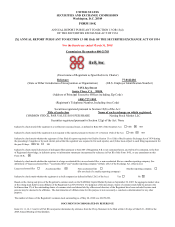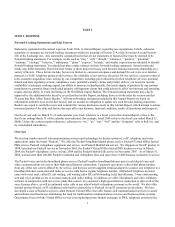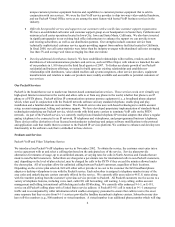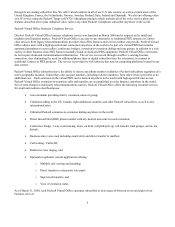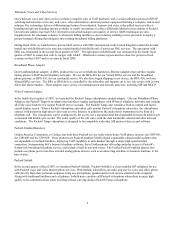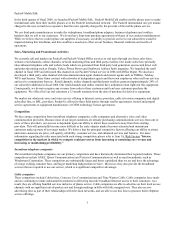8x8 2008 Annual Report Download - page 11
Download and view the complete annual report
Please find page 11 of the 2008 8x8 annual report below. You can navigate through the pages in the report by either clicking on the pages listed below, or by using the keyword search tool below to find specific information within the annual report.9
We currently employ 26 individuals in research, development and engineering activities in our facilities in Santa Clara,
California and Sophia Antipolis, France. Research and development expenses in each of the fiscal years ended March 31,
2008, 2007 and 2006 were $4.3 million, $4.7 million and $5.9 million, respectively. The reduction in research and
development expenses is due to difficulty in recruiting research and development employees to replace the loss of employees
and contractors during the year. We intend to grow research and development expenses in the future.
Regulatory
Although several regulatory proceedings are underway or are being contemplated by federal and state authorities, including the
FCC and state regulatory agencies, VoIP communication services have remained largely unregulated in the United States when
compared to traditional telephony services. To date, VoIP service providers have been treated mainly as information service
providers, although the FCC has thus far avoided specifically ruling on this classification. Information service providers are
largely exempt from most federal and state regulations governing traditional common carriers. The FCC is currently examining
the status of VoIP service providers and the services they provide. The FCC initiated a notice of proposed rule-making
(NPRM) in early 2004 to gather public comment on the appropriate regulatory environment for IP telephony. In November
2004, the FCC ruled that the VoIP service of a competitor and "similar" services are jurisdictionally interstate and not subject
to state certification, tariffing and most other state telecommunications regulations. The FCC ruling was appealed by several
states and on March 21, 2007, the United States Court of Appeals for the Eighth Circuit affirmed the FCC ruling.
Interconnected VoIP providers like us are required by the FCC to offer 9-1-1 emergency calling capabilities similar to those
available to subscribers of traditional switched phone lines. Moreover, interconnected VoIP providers were required to
distribute stickers and labels warning customers of the limitations associated with accessing emergency services through an
interconnected VoIP service, as well as notify and obtain affirmative acknowledgement from our customers that they were
aware of the differences between the emergency calling capabilities offered by interconnected VoIP providers as compared to
traditional, wireline providers of telephone service. The FCC’ s Enforcement Bureau released an order stating that the
Enforcement Bureau will not pursue enforcement against interconnected VoIP providers that have received affirmative
acknowledgement from at least 90% of their subscribers. We have received affirmative acknowledgement from substantially
all of our customers and have substantially satisfied this requirement of the rule.
Like many interconnected VoIP providers, we currently cannot offer VoIP E-911 services that route emergency calls in a
manner consistent with the FCC rules for all of our customers. We are addressing this issue with our VoIP E-911 Solution
providers. On November 28, 2005, we began routing certain 9-1-1 calls to a national emergency call center. The emergency
dispatchers in this national call center utilize the location information provided to route the call to the correct Public Safety
Answering Point, PSAP, or first responder. The FCC may determine that our VoIP E-911 solution for these customers does
not satisfy the requirements of the VoIP E-911 order because, in some instances, we will not be able to connect our subscribers
directly to a PSAP. We may be subject to enforcement actions including, but not limited to, fines, cease and desist orders, or
other penalties for those customers that we are unable to provide E-911 service in a manner consistent with the VoIP E-911
order.
On August 5, 2005, the FCC unanimously adopted an order requiring interconnected VoIP providers to comply with the
Communications Assistance for Law Enforcement Act, or CALEA. CALEA requires covered providers to assist law
enforcement agencies in conducting lawfully authorized electronic surveillance. Under the FCC order, interconnected VoIP
providers were required to comply with CALEA obligations by May 14, 2007 and make certain filings prior to that date.
Consistent with the relevant rules, we continue to work with a third-party solution provider to certify a CALEA-compliant
solution. As of May 14, 2007, we had installed this solution in our network operations and data centers, but had not yet
completed testing of all intercept capabilities of this equipment. We are working to complete the testing of this equipment in
order to certify full compliance with the FCC’ s order. We may be subject to enforcement actions including, but not limited to,
fines, cease and desist orders, or other penalties if we are not able to comply with CALEA.
On June 21, 2006, the FCC expanded the base of Universal Service Fund, or USF, contributions to interconnected VoIP
providers. The FCC established a safe harbor percentage of 64.9% of total VoIP service revenue to which federal USF
contributions apply. We were allowed to calculate its contribution based on the safe harbor or by submitting a traffic study that
would subsequently be approved by the FCC. For a period of at least two quarters beginning October 1, 2006, we were
required to contribute to the USF for our subscribers' retail revenues as well as through our underlying carriers' wholesale
charges. Beginning October 1, 2006, we began charging our subscribers a USF surcharge fee equal to the USF contribution
amounts we are required to contribute. The FCC order applying USF contributions to interconnected VoIP providers was
appealed and on June 1, 2007, the U.S. Court of Appeals for the District of Columbia ruled that the FCC was within its

